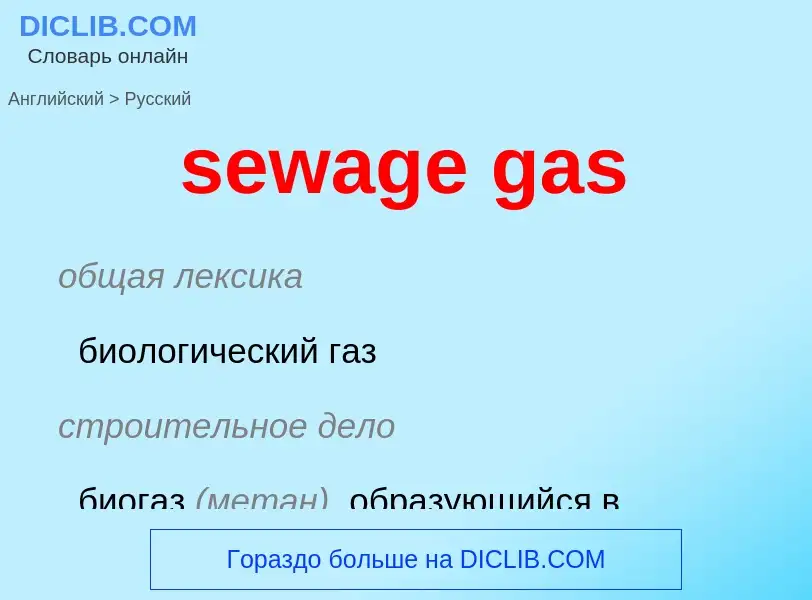Übersetzung und Analyse von Wörtern durch künstliche Intelligenz ChatGPT
Auf dieser Seite erhalten Sie eine detaillierte Analyse eines Wortes oder einer Phrase mithilfe der besten heute verfügbaren Technologie der künstlichen Intelligenz:
- wie das Wort verwendet wird
- Häufigkeit der Nutzung
- es wird häufiger in mündlicher oder schriftlicher Rede verwendet
- Wortübersetzungsoptionen
- Anwendungsbeispiele (mehrere Phrasen mit Übersetzung)
- Etymologie
sewage gas - Übersetzung nach russisch
общая лексика
биологический газ
строительное дело
биогаз (метан), образующийся в канализационных коллекторах
['s(j)u:idʒ]
общая лексика
сточные воды
ассенизационный
воды сточные бытовые
канализационный
канализационный водосток
сточный
строительное дело
неочищенные сточные воды
бытовые сточные воды
Смотрите также
существительное
общая лексика
нечистоты
сточные воды
редкое выражение
sewerage
Wikipedia

Biogas is a mixture of gases, primarily consisting of methane, carbon dioxide and hydrogen sulphide, produced from raw materials such as agricultural waste, manure, municipal waste, plant material, sewage, green waste, wastewater, and food waste. It is a renewable energy source.
Biogas is produced by anaerobic digestion with anaerobic organisms or methanogen inside an anaerobic digester, biodigester or a bioreactor.
Biogas is primarily methane (CH
4) and carbon dioxide (CO
2) and may have small amounts of hydrogen sulfide (H
2S), moisture and siloxanes. The gases methane, hydrogen, and carbon monoxide (CO) can be combusted or oxidized with oxygen. This energy release allows biogas to be used as a fuel; it can be used in fuel cells and for any heating purpose, such as cooking. It can also be used in a gas engine to convert the energy in the gas into electricity and heat.
Biogas can be compressed after removal of carbon dioxide and hydrogen sulphide, the same way as natural gas is compressed to CNG, and used to power motor vehicles. In the United Kingdom, for example, biogas is estimated to have the potential to replace around 17% of vehicle fuel. It qualifies for renewable energy subsidies in some parts of the world. Biogas can be cleaned and upgraded to natural gas standards, when it becomes bio-methane. Biogas is considered to be a renewable resource because its production-and-use cycle is continuous, and it generates no net carbon dioxide. As the organic material grows, it is converted and used. It then regrows in a continually repeating cycle. From a carbon perspective, as much carbon dioxide is absorbed from the atmosphere in the growth of the primary bio-resource as is released, when the material is ultimately converted to energy.


![Linköping, Sweden]] Linköping, Sweden]]](https://commons.wikimedia.org/wiki/Special:FilePath/BioGasBus.png?width=200)
![Biogas fueling station in [[Mikkeli]], Finland Biogas fueling station in [[Mikkeli]], Finland](https://commons.wikimedia.org/wiki/Special:FilePath/Biogas station.jpg?width=200)


![Ocean outfall]] pipes in [[Cape May, New Jersey]], United States – pipes exposed after the sand was removed by severe storm Ocean outfall]] pipes in [[Cape May, New Jersey]], United States – pipes exposed after the sand was removed by severe storm](https://commons.wikimedia.org/wiki/Special:FilePath/FEMA - 42863 - Outfall tubes in Ocean City beach.jpg?width=200)
![[[Greywater]] (a component of sewage) in a settling tank [[Greywater]] (a component of sewage) in a settling tank](https://commons.wikimedia.org/wiki/Special:FilePath/Greywater settling tank and grease trap (3109542163).jpg?width=200)
![Pumping station lifting sewage to the treatment plant in [[Bujumbura]], Burundi Pumping station lifting sewage to the treatment plant in [[Bujumbura]], Burundi](https://commons.wikimedia.org/wiki/Special:FilePath/Pumping station lifting the wastewater (6908385151).jpg?width=200)
![Screening of sewage at a sewage treatment plant in [[Bujumbura]], Burundi Screening of sewage at a sewage treatment plant in [[Bujumbura]], Burundi](https://commons.wikimedia.org/wiki/Special:FilePath/Screen (6619766435).jpg?width=200)
![Screening of the sewage with bar screens at a sewage treatment plant to remove larger objects in Norton, [[Zimbabwe]] Screening of the sewage with bar screens at a sewage treatment plant to remove larger objects in Norton, [[Zimbabwe]]](https://commons.wikimedia.org/wiki/Special:FilePath/Screening of the wastewater to remove larger objects. (6845984661).jpg?width=200)
![Lack of maintenance causing sewage to overflow from a manhole into the street of an informal settlement near [[Cape Town]], South Africa Lack of maintenance causing sewage to overflow from a manhole into the street of an informal settlement near [[Cape Town]], South Africa](https://commons.wikimedia.org/wiki/Special:FilePath/Wastewater in street (informal settlement near Cape Town), South Africa (2937833876).jpg?width=200)
